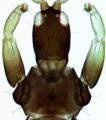Karnyothrips melaleucus
Recognition data
Distinguishing features
Female macropterous. Body bicoloured, head and thorax brown, also tube and abdominal segment IX; legs yellow, except fore femora largely brown; antennal segments II–V and basal half of VI yellow; fore wings weakly shaded medially, major setae pale but anal setae dark. Antennae 8-segmented, VIII broad at base; segment III slightly smaller than IV, III with 2 small sensoria, IV with 3 sensoria. Head longer than wide; postocular setae arising laterally, long and capitate; maxillary stylets scarcely one-fifth of head width apart, maxillary bridge narrow. Pronotum with anteromarginal setae no large than discal setae, remaining major setae capitate; fore tarsus with forwardly directed tooth. Prosternal basantra slightly longer than wide; mesopresternum transverse and slender. Fore wing weakly constricted medially, with 1 to 3 duplicated cilia. Pelta slightly longer than wide; tergites II–VII each with 2 pairs of sigmoid wing-retaining setae, these setae weak on II and VII; tergite IX setae S1 and S2 longer than tube and finely acute; tube shorter than pronotum, anal setae much longer than tube. Male very similar to female, but fore wing with no duplicated cilia; tergite IX setae S2 short and stout; sternite VIII without a pore plate.
Related and similar species
About 45 species are listed in the genus Karnyothrips, but it is questionable how many of these should be placed in the same genus. The species are similar to Haplothrips species in structure, but have a fore tarsal tooth that is forwardly directed and hook-like, and long anal setae. A key to 14 species from Central and South America that have been placed in this genus was given by Mound & Marullo (1996), and a key to 11 species from Japan was given by Okajima (2006), whilst Stannard (1968) included three North American species within his treatment of the genus Haplothrips. The problems in distinguishing between these two genera are discussed by Mound & Minaei (2007). K. melaleucus differs from other members of the genus in the position of the maxillary stylets close together medially in the head, the yellow abdomen in contrast to the brown head and thorax, and the long, acute setae S1 on tergite IX that extend beyond the apex of the tube.
Taxonomic data
Current valid name
- Karnyothrips melaleucus (Bagnall)
Original name and synonyms
- Hindsiana melaleuca Bagnall, 1911: 61
- Zygothrips bicolor Hood & Williams, 1915: 126
- Cephalothrips elongatus Watson, 1919: 3
- Hindsiana pini Watson, 1922: 65
- Hindsiana cocois Watson, 1922: 66
Family placement
Phlaeothripidae, Phlaeothripinae
Biological data
Life history
Apparently predatory on various Coccoidea, but possibly also on mites. .
Host plants
Collected from leaves, but also from dead branches and dead twigs.
Tospoviruses vectored
None
Crop damage
None
Distribution data
Area of origin
Probably Oriental region
Distribution
Widespread around the world in tropics and sub-tropics; one male is recorded from Taiwan, and one male has been collected on Boigu Island, Queensland. This species is likely to be taken in quarantine at California.





